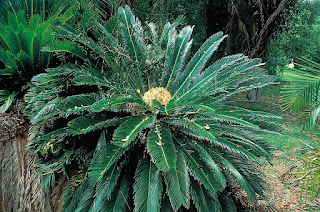
Cycads are a type of plant that first appeared on the planet 280 million years ago, during the Permian period. During the Jurassic and Triassic periods, these plants were dominant. When flowering plants appeared on Earth, the number of cycads began to decline. So far, scientists have described 305 cycad species, but they believe the true number of cycads is much higher (more than 400 species in total). Cycads are found all over the world. China, Vietnam, Australia, South Africa, and Mexico are home to 70% of all species. Cycads can live in a variety of environments, including tropical rainforests, deserts, swamps, sand, and rocky areas. Cycads are seed plants with a stout, woody trunk and a crown of large, hard, stiff, evergreen, pinnate leaves. Because the species is dioecious, the individual plants of a species are either male or female. Cycads range in size from a few centimeters to several meters in height.
The size of cycads varies according to species. They can grow to be a few inches or several feet tall.
Cycads have a cylindrical woody stem that is devoid of branches. Corky bark covers the stem.
The crown is made up of large, hard, elongated leaves that grow straight from the stem. The leaves are arranged in a rosette pattern. New leaves sprout in the crown’s center. Cycads have evergreen leaves that are either pinnate (feathery) or deeply cut.
During the extremely hot and dry season, certain cycads shed their leaves.
At first glance, some cycads resemble palm trees, while others resemble ferns. Despite their morphological similarities, cycads, palms, and ferns are not genetically related.
Cycads live in symbiosis (a mutually beneficial relationship) with cyanobacteria, which can fix nitrogen from the atmosphere. These bacteria produce neurotoxin, which can be found in a variety of plant parts, including the seeds.
Flowers are not produced by cycads. On separate plants, male and female reproductive organs develop (dioecious).
Male plants produce egg-shaped cones that range in color from yellow to brown. Ovules and seeds are produced by female plants on leafy structures known as sporophylls.
Pollination is handled by the wind and beetles. Cycads emit a distinct odor that attracts beetles and ensures successful pollination.
Cycads produce small seeds with yellow or reddish flesh covering them. Despite the fact that seeds contain toxins, they are consumed by humans in some parts of the world.
Cycads can be grown as houseplants. Seeds or tissue cuttings can be used to propagate them.
Many animals rely on cycads for food. Larvae of certain butterflies and ants eat the leaf secretion, cattle eat the leaves, and fruit bats eat the seeds.
In India in the ninth century, cycads were used to make flour.
Certain cycads are known as bread trees because they contain starch, which is an important part of indigenous people’s diet.
Cycad leaves and cones are used in traditional Asian medicine.
Most cycads grow slowly, but they can live in the wild for over 1000 years.










Hi there! I wanted to take a moment to tell you how much I enjoy reading your blog. Your writing is so informative and thought-provoking, and I always appreciate the new insights I gain from your posts. Thanks for all the hard work you put into your content!